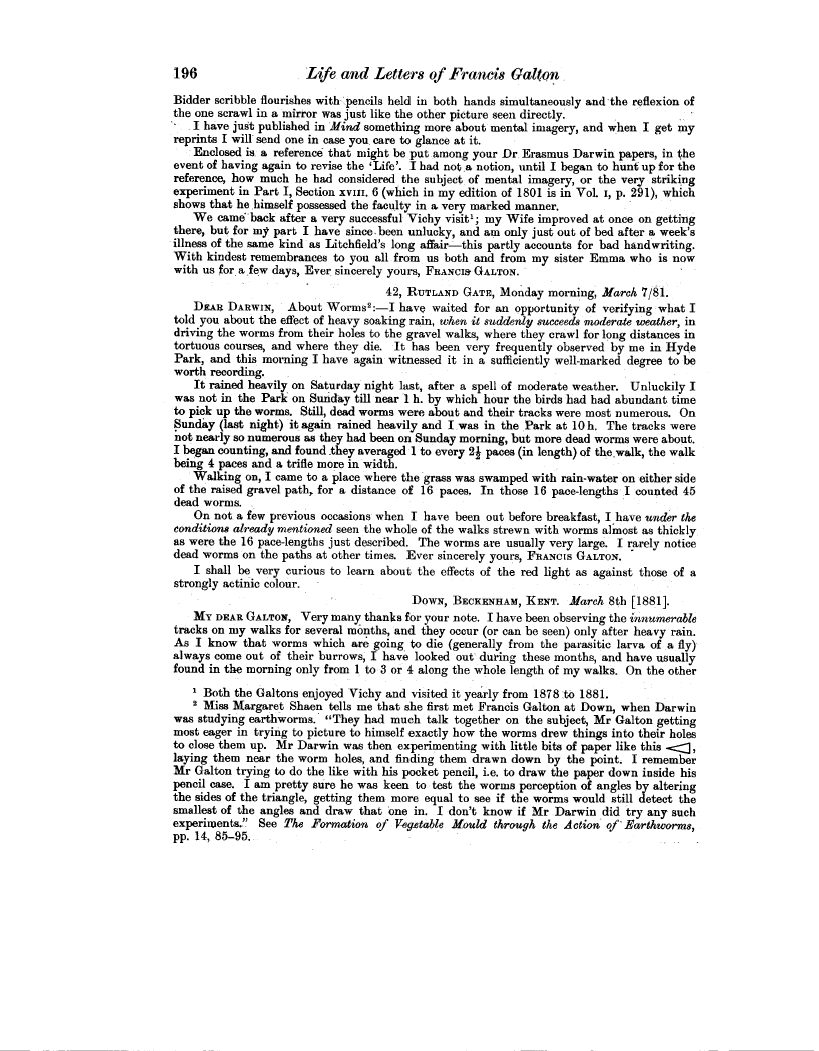196 Life and Letters of Francis Galtton
Bidder scribble flourishes with-pencils held in both hands simultaneously and the reflexion of the one scrawl in a mirror was just like the other picture seen directly.
I have just published in Mind something more about mental imagery, and when I get my reprints I will' send one in case you. care to glance at it.
Enclosed is a reference that might be put among your Dr. Erasmus Darwin papers, in the event of having again to revise the `Life'. I bad nott a notion, until I began to hunt up for the reference, how much he had considered the subject of mental imagery, or the very striking experiment in Part I, Section xviii. 6 (which in my edition of 1801 is in Vol. i, p. 291), which shows that he. himself possessed the faculty in a very marked manner.
We came -back after a very successful Vichy visit'; my Wife improved at once on getting there, but for my part I have since. been unlucky, and am only just out of bed after a week's illness of the same kind as Litchfield's long affair-this partly accounts for bad handwriting. With kindest remembrances to you all from us both and from my sister Emma who is now with us for_ a few days, Ever sincerely yours, FRANCIS GALTON.
42, RUTLAND GATE, Monday morning, March 7/81.
DEAR DARWIN, About Worms2:-I have waited for an opportunity of verifying what I told you about the effect of heavy soaking rain, when it suddenly succeeds moderate weather, in driving the worms from their holes to the gravel walks, where they crawl for long distances in tortuous courses, and where they die. It has been very frequently observed by me in Hyde Park, and this morning I have again witnessed it in a sufficiently well-marked degree to be worth recording.
It rained heavily on Saturday night last, after a spell of moderate weather. Unluckily I was not in the Park on Sunday till near 1 h. by which hour the birds had had abundant time to pick up the worms. Still, dead worms were about and their tracks were most numerous. On Sunday (last night) it again rained heavily and I was in the Park at 10 h. The tracks were not nearly so numerous as they had been on Sunday morning, but more dead worms were about. I began counting, and found.they averaged 1 to every 2J paces (in length) of the, walk, the walk being 4 paces and a trifle more in width.
Walking on, I came to a place where the grass was swamped with rain-water on either side of the raised gravel path, for a distance of 16 paces. In those 16 pace-lengths I counted 45 dead worms.
On not a few previous occasions- when I have been out before breakfast, I ,have under the conditions already mentioned seen the whole of the walks strewn with worms almost as thickly as were the 16 pace-lengths just described. The worms are usually very large. I rarely notice dead worms on the paths at other times. Ever sincerely yours, FRANCIS GALTON. -
I shall be very curious to learn about the effects of the red light as against those of a strongly actinic colour.
DOWN, BECKENHAM, KENT. March 8th [1881].
MY DEAR GALTON, Very many thanks for your note. I have been observing the innumerable tracks on my walks for several months, and they occur (or can be seen) only after heavy rain. As I know that worms which are going to die (generally from the parasitic larva of a fly) always come out of their burrows, I have looked out during these months, and have usually found in the morning only from 1 to 3 or 4 along the whole length of my walks. On the other
' Both the Galtons enjoyed Vichy and visited it yearly from 1878 ao 1881.
2 Miss Margaret Shaen tells me that she first met Francis Galton at Down, when Darwin was studying earthworms. "They had much talk together on the subject, Mr Galton getting most eager in trying to picture to himself exactly how the worms drew things into their holes to close them up. Mr Darwin was then experimenting with little bits of paper like this Q, laying them near the worm holes, and finding them drawn down by the point. I remember Mr Galton trying to do the like with his pocket pencil, i.e. to draw the paper down inside his pencil case. I am pretty sure he was keen to test the worms perception of angles by altering the sides of the triangle, getting them- more equal to see if the worms would still detect the smallest of the angles and draw that 'one in. I don't know if Mr Darwin did try any such experiments.'.' See The Formation of Vegetable Mould through the Action' of ' Earthworms, pp. 14, 85-95.

